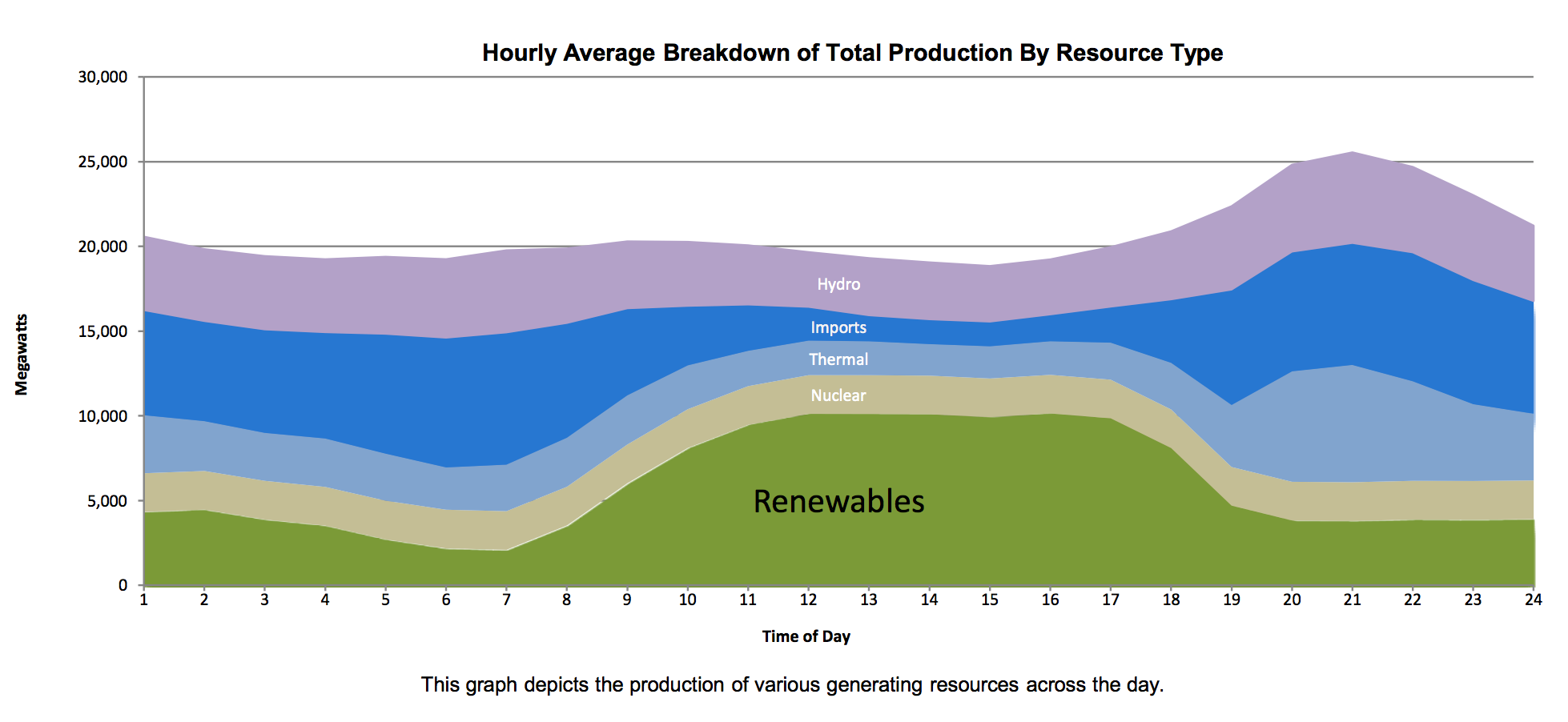While Americans chose to curtail wind and solar rather than conventional energy, the Germans say baseload plants (coal and nuclear) are the problem. That’s because the matter isn’t simply technical, though it is described as such. It’s mainly political. Craig Morris explains.

Too much wind and solar – or too much coal and nuclear? (Public Domain)
“Right now, California has too much renewable electricity,” write our friends at the Berkeley Haas blog once again. We have tried to show them that their duck is safely afloat, but they insist that renewables are the problem, not the goal.

Power production on 9 April 2017 in California. When renewable power peaks at 50% of demand, Californian experts say there is too much. Renewables peak at that level and higher frequently in Germany, but the Germans speak of too much must-run coal and nuclear. Source: CAISO (PDF)
In Germany, a debate is now raging over this issue as well. Economist Claudia Kemfert says (in German) that inflexible coal and nuclear plants can’t ramp down to make space for renewables. Felix Matthes of Öko-Institut counters (in German) that the matter is more complicated, but that coal plants nonetheless need to be shut down.
Kemfert’s new book (in German) The fossil empire strikes back: why we need to defend the Energiewende now is only one reason for the discussion. Another is the government’s answer in March to the parliamentary query by the Greens on must-run capacity (in German). The Greens wanted to know why so much conventional power is still generated at times of low / negative spot prices; green electricity has priority grid access by law (which is not the case in California, by the way).
The government answered that the reasons are “not generally due to grid restrictions” but rather “income opportunities outside the power market” and “technical power plant restrictions.” The former basically is cogeneration, so the plants make money selling heat regardless of the power prices. The latter is the must-run level of conventional plants, meaning they cannot ramp down any lower. (I explain must-run capacity here.)
This answer is based on a recent 85-page study (PDF in German) from the Network Agency. It has two main findings for data from 2015:
- The amount of conventional capacity needed for grid stability was around 3.2 to 4.6 GW; these plants then help stabilize frequency (which wind and solar also do).
- However, must-run capacity came in at 18.8 to 23.6 GW. Germany thus had some six times more coal and nuclear plant capacity than it needed for grid stability.
Because these plants collectively cannot ramp down below around 20 GW, they continue running regardless of what the price level is on the power exchange.
But in contrast to the discussion in California, none of the Germans say there is “too much renewable electricity.” As the Network Agency puts it: “Nuclear and lignite plants… account for 69 to 73 percent of this {must-run} output.” Renewables are the goal, and you can’t frame your aim as an obstacle. If high levels of renewables are the goal, then inflexible coal and nuclear must go.
Note the different focus in Germany. The Network Agency begins its Executive Summary thus:
“The German government’s long-term goal is a carbon-free, non-nuclear generation structure. Efforts must therefore be made to reduce, to the extent possible, the share of conventional generation that is required for supply security but does not respond to price signals.”
In its parliamentary response, the German government writes:
“As a part of the optimized power market 2.0, the government aims to increase the flexibility of generation and remove obstacles towards lowering must-run capacity.”
California is a long way from Germany!
However, according to the Guardian, the European Commission is considering doing away with priority dispatch for renewables, and Chancellor Merkel seems to like the idea (in German). The Guardian article claims that “fossil fuel power providers argue that renewables have the lowest operating costs and so would anyway receive priority access to the grid network,” which is clearly not the case in California. Indeed, though the numbers are hard to find, wind and solar seem to be curtailed more often outside Germany, even in countries with less wind and solar.
In short, Germany has already reached the technical limits of its conventional fleet. California has not, I assume, though no investigation of the must-run level has even occurred in California; the Berkeley Hass blog post speaks only vaguely of “operating constraints” without a number. Otherwise, the author merely states “it may not be practical to cycle nuclear generation on a day-to-day basis.” Impractical is putting it mildly; Americans continue to depict nuclear as much more flexible than it is, as I will discuss in my next few posts. Judging from the comments below that Berkeley Hass blog post, most readers seems to think that nuclear can ramp, but no one ever provides evidence of an entire fleet doing so. I aim to fill that gap.
Craig Morris (@PPchef) is the lead author of Global Energy Transition. He is co-author of Energy Democracy, the first history of Germany’s Energiewende, and is currently Senior Fellow at the IASS.
Good. A similar situation to California’s arose in China. Large volumes of wind and solar capacity was being curtailed because provincial governments had struck sweetheart deals with coal generators assuring them of despatch priority. Eventually Beijing put its foot down ans ordered despatch priority for renewables. There is still a lot of wasted wind ans solar capacity in the remote western provinces. Whether this is down to grid connection issues, a surplus from inadequate transmission capacity, or simple flouting of the new policy, I don’t know.
Thanks for the post. There was a bit that I didn’t quite understand. In the bullet points you say a study found that the “conventional capacity needed for grid stability was around 3.2 to 4.6 GW” but the “must-run capacity came in at 18.8 to 23.6 GW.” What is the cause of this 6-fold difference?
I went to the link where you said you explained must-run capacity, but that appears to be a per-plant number. Are you implying that Germany can lower the fleet-wide must-run level without jeopardizing grid stability by shutting down some nuclear plants and coal plants? If so, then wouldn’t getting rid of priority dispatch for renewables get rid of an incentive for un-necessary coal plants to be retired? If grid priority dispatch for renewables were maintained, wouldn’t coal plants be shut down as uneconomic, thus lowering the fleet-wide must-run level? If not, why not? Is it that these plants are needed locally to deal with grid-congestion issues? Or is it a political issue?
[…] with wind & solar is cheaper in the mid-term, but eventually wind and solar peaks will hit the must-run capacity of nuclear, and then storage is needed. Storage will make everything much more expensive. So German […]
California imports about 25% of it’s electricity. Those imports were supplied by the other 2 regions that make up the Western Interconnect (WECC). The Northwest region of WECC, which includes most of Colorado, Idaho, Nevada, Montana, Oregon, Utah, Wyoming, Washington, and a small area of northern California, supplied a daily average of 122 million kWh. The bulk of the remaining imports to the California region, 68 million kWh per day on average, came from the Southwest region of WECC, which includes much of Arizona, New Mexico, and small portions of Nevada and Texas.
The daily peak in system demand for the California region and the entire Southwest occurs during the summer, driven by air-conditioning load. Conversely, the heating load drives peak demand in the Northwest, where the daily peak during 2016 was on December 8.
It’s not clear how much of it comes from sources such as NG, coal and hydro sources. Since the EIA showed that only 3.2% of US consumption came from wind and solar I don’t think California imported much of that.